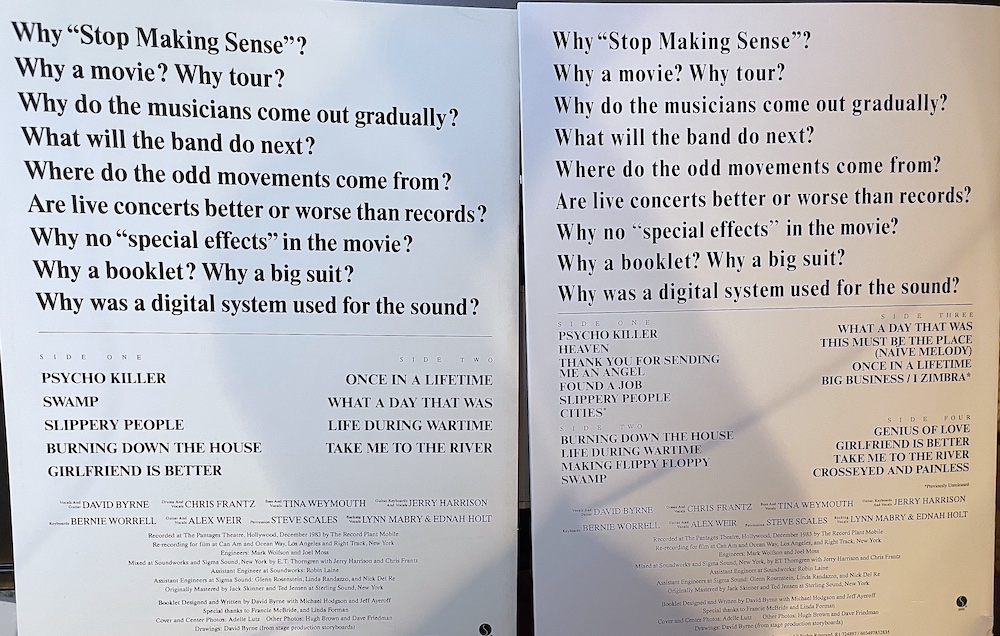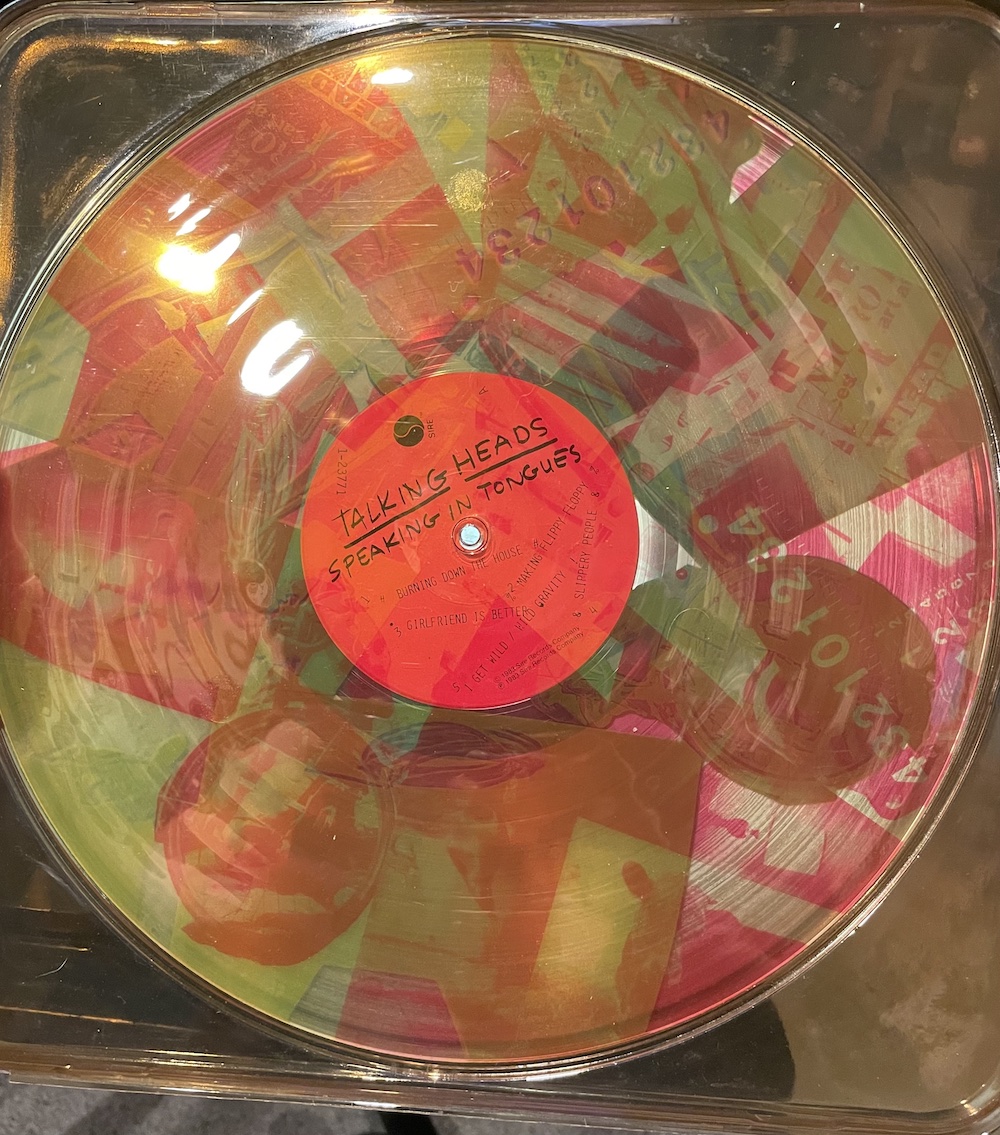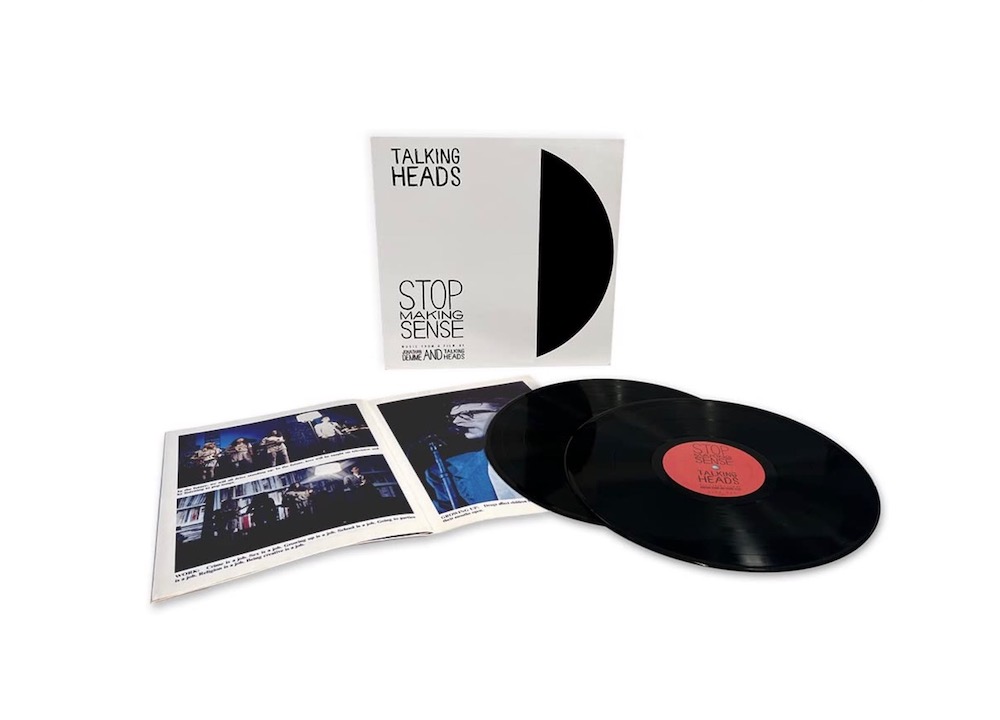"Stop Making Sense" Gets Re-Mastered and Issued-in-Full on Limited Edition Double LP Set
for the first time you get the full live concert set list (on vinyl), but what about the sound?
(There are two reviews of this record published simultaneously, one by Michael Fremer and one by Malachi Lui, the two working independently, for a young and an "I was around then" perspective).
Chris Frantz writes in the updated booklet packaged with this new double LP set of the difficulties involved in mounting the complicated, unique, never before (or since) seen stage show that the late Jonathan Demme so well captured in the film "Stop Making Sense". "...the first production manager got an ulcer and quit", Frantz writes. Sorting out certain aspects of this limited edition reissue, which is accompanied by a new 4K and IMAX roll-out celebrating the film's 40th anniversary, is almost ulcer producing (more later about the upcoming festivities).
The new booklet is an update of the one accompanying the limited edition of the original LP, which asks a number of questions, one of which is "Why was a digital system used for the sound?"
 That was the question I had after buying and listening to the original record. None of the questions are answered in the original booklet. The updated booklet, with new notes by Tina Weymouth, husband Frantz, David Byrne, and Jerry Harrison, answers some of the questions, which Byrne quips were originally included in the hope that journalists wouldn't ask them. Of course they did!
That was the question I had after buying and listening to the original record. None of the questions are answered in the original booklet. The updated booklet, with new notes by Tina Weymouth, husband Frantz, David Byrne, and Jerry Harrison, answers some of the questions, which Byrne quips were originally included in the hope that journalists wouldn't ask them. Of course they did!
Byrne's annotation mentions that he found it odd that "...for many people, this album was their introduction to Talking Heads". Byrne credits the film and the "improved mixes and sound quality" for helping popularize the band with this new, larger audience. Byrne writes, "This show, this collection of songs, was a kind of history of the band up until that point." Of course, by that time, long time fans knew all of the songs and albums, especially the groundbreaking Brian Eno produced ones. And here they got to hear the familiar songs in highly energized versions.
Starting in 1980 and for three subsequent tours the quartet had doubled in size, adding keyboardist and Parliament-Funkadelic founding member Bernie Worrell, percussionist Steve Scales, rhythm guitarist Alex Weir and background singers Lynn Mabry and Edna Holt.
Previous to the Pantages appearances, the group had been on tour supporting the album Speaking in Tongues— released June, 1983. By the time they hit Hollywood Boulevard Talking Heads was a well-grooved ethno-rhythmic powerhouse bearing scant resemblance to the quartet that emerged from CBGBs as part of the "punk/new wave" scene—not that this group of well-educated kids fit into that construct (Byrne, Weymouth and Frantz met at RISD [Rhode Island School of Design], Harrison graduated Harvard).
Speaking In Tongues, the group's first post Brian Eno effort was its highest charting, reaching #15 on the Billboard top 200. It also crossed over to the dance charts, reaching #2. A wholly appropriate result given the band's musical direction.
 The limited edition Robert Rauschenberg edition
The limited edition Robert Rauschenberg edition
This new double LP provides for the first time (as best as I can tell) the original set list in the correct running order. The 1999 DVD included all of these tracks, but with "Cities" and "Big Business/I Zimbra" tacked on following "Cross Eyed And Painless". Also, the DVD features a "digitally re-mixed and re-mastered" soundtrack available in three mixes: a Dolby Digital 5.1 feature film mix (by Jonathan Porath at Sony Music Studios supervised by Byrne), a 5.1 DD studio mix (created by original mixer E.T. Thorngren and Jerry Harrison using the original multi-track theatrical mix tapes) and 2 channel stereo mix (created using the 5.1 mix). Whew!
 After listening to the original vinyl record back in 1984 I asked the same question: "Why was a digital system used for the sound?" I hated the sound! It didn't sound like any good live recording I'd ever heard, good or bad. It sounded threadbare, artificial, sucked out in the midrange, skeletal and as if it had been recorded in a cave. Drums do not sound like that! Cymbals especially don't sound like that! Now maybe Chris Frantz disagrees and likes the drum sound, and after all he's the guy who played them, but from where I sit, there's no shimmer, no sizzle and lots of air brake "shhhhsshh".
After listening to the original vinyl record back in 1984 I asked the same question: "Why was a digital system used for the sound?" I hated the sound! It didn't sound like any good live recording I'd ever heard, good or bad. It sounded threadbare, artificial, sucked out in the midrange, skeletal and as if it had been recorded in a cave. Drums do not sound like that! Cymbals especially don't sound like that! Now maybe Chris Frantz disagrees and likes the drum sound, and after all he's the guy who played them, but from where I sit, there's no shimmer, no sizzle and lots of air brake "shhhhsshh".
I wrote about it somewhere, maybe in the Los Angeles-based "Music Connection" magazine. Little Feat's Waiting For Columbus had come out in 1978 recorded to analog tape and comparing this to that or comparing Talking Heads' own The Name of This Band is Talking Heads a double LP released in 1982 consisting of late 70s era quartet recordings on one disc and the new expanded group on the other. This sounded like a live album, not like an artificial construct.
The new booklet answers the "Why was a digital system used for the sound?" question. Or sort of does. In his notes, Harrison writes, "Stop Making Sense was recorded on two Sony digital 24 track tape recorders", which he says were used "for the recording and mixing of the film". Why? "To avoid any degradation in sound..." I assume he meant generational loss caused by having to transfer masters to sprocketed 35MM mag tape to maintain synch with picture. However, he also points out that for whatever unexplained reason or reasons there were "certain effects" that required sprocketed mag tape while the Sony tapes used for synch SMPTE time code.
Harrison writes that at the time "synchronization of audiotapes for film was in transition". This was 1984. I feel I must insert here that two years earlier in 1982, for the TRON soundtrack I supervised, we synched analog tape to film (one track had SMPTE time code), bypassing the transfer to sprocketed mag tape and saving a generation. To complete this process Wendy Carlos had synched her 3 track tape recorder to Sony U-Matic film transfers. Ok, I digress but.....
Speaking of which, in doing research for this review I found a reference to Stop Making Sense in sound engineering magazine (Recording Engineer/Producer Vol. 16, Number 5 October, 1985) that claimed the original multitrack Pantages theater recordings were to analog multitrack tape! And that the transfer to Sony's PCM 3324 was done in post production for the purposes Harrison outlined. Could those analog tapes (if that story is true) really have sounded as artificial and unusual as the 1984 LP sounds? Do the analog tapes exist? How about an AAA SMS? The performance would be worth it. Or am I just fetishizing this because the 3324 is transparent to the source and so that's what the recording first sounded like?
Meanwhile, back in the real world, in addition to this 2 LP set, there's a "digital" version (for streaming, which I didn't check out) and as a new Dolby Atmos mix by Jerry Harrison and E.T. Thorngren. Dolby Atmos for a live concert starts making sense even for Luddite me.
Ted Jensen remastered this 2 LP vinyl reissue, though it's not clear what the source was: was it the original mix for the nine tracks on the original LP and remixes from 1999 for the remainder? The 1999 2 channel mix for all? I didn't do an A/B forensic deep dive to figure that out because what's the point?
As on the original, the record omits David Byrne's famous opening line "Hi, I've got a tape I want to play" (though the tape and boom box were just props). Joe Nino-Hernes cut lacquers even though Chris Grainger who is the production and booking manager at Sterling, Nashville gets the credit. Who put together and approved that?
I went back for the first time in a long time to listen to the original record. Two conclusions: not playing it because of the sound, was foolish. It's a great performance worthy of many listens i missed over decades (I played the studio albums plenty of times). Secondly, while the sound is still "otherworldly" oddly sucked out and features some seriously anemic sounding cymbals, I've made peace with this kind of digital sound (assuming it was digital to begin with!) and don't find it as objectionable as I once did.
I cranked up "Psycho Killer" and it was thrilling: big soundstage, popping drum machine with appropriately sharp transients, good dynamics and clarity to the acoustic guitar Byrne was slamming and the picture was more three-dimensional and involving than I remembered it being (but then my system is far more evolved). The bottom end on the original goes deep. The artificial percussion sounds well, convincingly artificial. The audience still sounds plain theadbare. On later tracks, the real cymbals sound artificial, etc. But as I wrote, I made peace with it (as if "it" cares).
I put on the reissue and some serious "executive decisions" were made somewhere along the line. As on the original, Ted Jensen mastered this reissue, though the term means something different in 2023 than it did in 1984. Back then veteran cutting engineer Jack Skinner and Ted Jensen get mastering credit. How they shared the credit isn't clear but for the 2023 reissue things are clearer: Ted Jensen prepped the files and Joe Nino-Hernes probably did a straight cut from the prepped file.
Here's what Ted did this time that he didn't do last time: he pushed up the mid bass to give the picture more warmth and he slightly suppressed the top and to some degree limited dynamics. All of which does a disservice to the recording and more significantly to the performances. The original ripples with excitement and energy. The reissue sounds kind of stodgy and wet-blanketed. Compare "Burning Down the House" or compare on both versions the drums and soundstage size on "Girlfriend is Better" if you can. Jensen has buried a sizzle sibilance in Byrne's vocals, which is good, but the cost is too high. For some reason this is a limited edition. Despite the sonic disappointment I still recommend finding a copy if you can before they are all gone. It'll still have you dancing.
BTW: the production credits are far better on the 1999 DVD than they are on both the original LP edition and on this reissue.
Last evening after publishing this review I played the 1999 DVD and it sounded great: plenty of midrange giving voices body and weight, plus far greater dynamic range.That’s no guarantee the mix translates well to a purely aural experience but it tells me the vinyl. sound was a choice not a recording restriction.
As for the planned film version roll-out: there's a global IMAX Live event September 11th for a new 4K restoration (hopefully an eventual 4K Blu-ray release), in IMAX September 22nd and "everywhere" September 29th. The special IMAX Live 40th anniversary event will include a screening of the film followed by a Q&A, which will be live-streamed from TIFF to select IMAX theatres around the world, and moderated by filmmaker Spike Lee with all four original band members in attendance. That should be interesting.
k











































